|
Utsav Pandya Management Student, Mukesh Patel School of Technology Management & Engineering, NMIMS, Mumbai. |
Rishi Rungta Assistant Professor, School of Pharmacy & Technology Management, NMIMS, Mumbai.) |
Geetha Iyer3 |
Taxi market in India is growing rapidly with a lot of new entrants who run private taxi companies apart from the existing public taxi market. The public taxi market consists of taxis that are too old with very little comfort and safety, while on the other hand the taxis in the private taxi market are modern along with features like GPS, more comfort and safety. Thus, to study the impact of the private taxi companies on the public taxi market, we have carried out this research by using specific variables that will explain the effect of the private taxi market on the public taxi market. These variables have been taken into account considering the usual factors that a customer might think of while thinking hiring a taxi. So according to the variables considered, a theoretical framework was developed containing the dependent and independent variables along with the null and alternate hypotheses that had to be proved true or false depending upon the data collection. A questionnaire was prepared with the help of which two sets of data were collected of the public taxi market and the private taxi market through a survey filled by people chose at random using the random probabilistic sampling technique. The data collected was analyzed using the SPSS software and Minitab software for which a set of analysis techniques were applied and the data was interpreted which helped in proving the corresponding null or alternate hypotheses true as per the requirement of the research.
India is a developing nation and also with this on-going development, the standard of living of the middle class people has raised leading to an increase in the wants and needs of this middle class. Not all people from this middle class background have the ability to buy personal vehicles for travelling hence they highly depend on Public Transport Services. One of the most important source of Public Transport Services are the Taxis which are used by lakhs of Indian citizens every day to commute to their workplace, go to shopping with their family, go to places for holidays, go to the airport and the list continues.
Focusing on getting cabs for short distances within a particular city or for going to the airport or from the airport to some particular place, it was very inconvenient until a few years ago. However, since the Radio cabs have entered in the Taxi market, through the use of technology like mobile apps to book these cabs the situation has totally changed in India. This Radio cab market has grown so enormously that the number of radio cabs has increased way more than the number of public taxis on the road till today. According to a study done by Sunstone Business School, the radio cab market has grown with almost more than 15,000 cabs with large multi-city operators like Meru, Taxi for sure, Uber, Tab Cab, Ola, etc. holding around 70% of the market share along with several other new operators in the several cities. Despite this tremendous growth in the last few years, the radio cabs are just a minuscule portion of the entire private taxi operators in the cities. For example, in Mumbai though the number of radio cab offering is less than 10% of the overall market share, the demand of these radio cabs has been rising with the rise in the middle class as even they seek better transport.
Radio cab operators have shifted from catering to just airport pickups and drop-offs to providing commuting services in large cities from one point to another. These radio cab operators usually earn between 30-50% of their revenue from the airport pickup and drop-off services they provide. But with the increase in the demand of these radio cabs within the city for point-to-point commuting, rising fares of the public transport and the parking fare at the airports, these radio cab operators are looking for new ways to cater to point-to-point commuting demand such as on demand cabs using the smartphones having mobile apps for booking the cabs. The Taxi market is slowly beginning to see the emergence of the aggregation models from the new as well as the existing operators in the point-to-point commuting segment. New operators have now debuted as powerful players such as Savaari, TaxiGuide, Taxi for Sure and Ola Cabs who are supported by Venture Capitalist firms like Inventus Capital, Accel Partners, Tiger Global Management, Helion and Blume are now becoming a threat to the Public Taxi market as these operators are providing the customers with far more better services like on demand booking of taxi using the mobile apps, Taxis having GPS so that the customer can track the cab in real-time, cabs that are more comfortable and safe as compared to the Public Taxis. The current study will study the impact of parameters on the Public Taxi.
Statement of the Problem
To study the current scenario of taxi market in India and understand the effect of various variables like Technology Trends, Safety, Comfort, Ease of Availability, Tariff and Different Payment Options affecting the taxi market currently and to study the impact of these variables on radio cabs and public taxis that make an impact on consumer preference as a means of transport for both the medias.
Literature Review
The articles and reports reviewed talks about the revolutionary change that India is witnessing in the urban road passengers from traditional way of travelling in horse carriages to the modern fleet cabs handled by private companies, radio taxi & cars on rent.
There different models of operating the business in India:
Self-Drive Model: This model was popularized by Zoom Cars in India and it is also similar to the model which was followed by companies in the developed countries like Hertz and Avis. This company provides cars on a rental basis to the commuters charging them on an hourly basis or daily basis wherein the payment is made in advance. The main advantage of this model is the cost efficiency as this eliminates the costs of hiring a driver and provides flexibility of time. (Amit Jain, 2015).
The Indian Taxi market is dominated by the unorganized taxi sector, but the organized radio taxi service market which has been growing over the past five years. The changing lifestyle of the middle class has also set the radio taxi market in India growing. The radio taxis have witnessed an increase of tenfold between 2009 and 2013. Metro cities have witnessed this exponential growth with the penetration of organized sector continuing to be very low in tier 2 and tier 3 cities as the people in these cities prefer other economical alternatives because of low per capita income. Many Radio taxi operators provide 24x7 services throughout the year. Though these companies charge high fares as compared to the unorganized taxis and public transportation, the services provided by the organized segment is much better than the unorganized segment. Due to the rapid urbanization, changing lifestyles and the improvements in the technology in commutation, the Indian Taxi market has increased in both value and volume terms. The revenues of the radio taxi services are forecasted to grow at a CAGR of about 25% during 2014-2019. (Reuters, 2014).
The report talks about the growing taxi business in India which is growing at a healthy rate of 20-25% ever year, the organized sector of taxi market alone which has accounted for just 4-5% of taxi market in India and is expected to grow to $7 billion by 2020 where companies like Ola, Uber and Taxi for Sure that operate as Taxi Aggregators. The revenue model of taxi aggregators is such that they do not employ the taxi drivers or own the fleet cars but earn commission in the range of 10-20% of the driver’s journey. The long term strategy for making profits in the taxi market is by Monopolization of the taxi market. Though the fares are low the normal radio taxi cabs and other taxi operators will not be able to match this low pricing scheme adopted by the organized sector. These aggregators will then establish a monopoly which will enable them to have the freedom of charging very prices even from the cartels and exploit the consumers taking them for a ride. Once the customers get used the services provided by them the aggregators will charge three to four times fare to recover the losses. The taxi aggregators masquerade as technology companies which are grossly misleading and so scot free of the regulations set by the government which is governing the regular taxi operators. The technology quotient of taxi aggregators is a misnomer since radio cabs were the first to adopt the technology employing radio networks, GPS tracking and bookings through websites and smartphone applications. The taxi aggregators avoid paying service taxes by masquerading as technology companies from different jurisdictions much like the e-commerce companies. (Kunal Lalani, 2015).
The article says that the organized cab service forms a small part of the total taxi market. And according to the market analysts the taxi market is estimated to operate about 60,000 cabs in India which includes the private fleet owners and taxis based on aggregation model. Online bookings account for a minuscule share of their business for the traditional radio cab companies based on ownership model. According to a research, operators working on the traditional ownership model or specifically radio cab companies have an average of 30-40% of their bookings on website and smartphone applications. But the online taxi aggregators boast that their way of doing business is superior to the traditional radio taxi operators. The aggregator based taxi service through online services is expected to grow at a CAGR of 36% over the next 5 years. The growing online taxi market of India will predominantly owe to rise in the disposable income of the population in a growing corporate sector. Despite the growth potential of the market the high fares along with the increasing operating costs are the basic challenges which will threaten to pull down the business. (Netscribes Industry Insights, 2015).
The report focuses more on Deregulation than Regulation of the taxi services. Uber says that it is a rideshare service and not a taxi service wherein the taxis cruise the roads seeking fares but ridesharing services do not rely on apps to arrange a form of carpooling. Because of this minor distinction Uber has successfully argued that it should remain immune to the taxi regulations. Since not being categorized as a taxi provides rideshare companies like Uber with a pricing advantage. Taxis are to run on pre-approved prices by the government. Uber is rideshare service hence it has the flexibility to raise and lower its fares based on demand. Because of this Uber undercuts fares of the taxis during off-peak times and charges high fares during high demand periods. Taxi companies are defensively lobbying to regulate the ridesharing services which will lead to more competition and thus leading to deregulation which will allow every car service to set their own fares. Uber’s pricing model of Peak and off-peak should be adopted by the taxis which would allow the taxis to benefit from flexible pricing in on-street pick-ups where they still have a monopoly. Apart from pricing, distance is also important when it comes to profitability. Companies should creatively use price to focus on per trip profitability. Riders, for example, can input their origin and destination into an app and receive a customized quote that takes into account the profitability derived from longer distances i.e. discounted prices for longer trips. The difference between taxis and ridesharing is that the drivers in ridesharing model are inexperienced and rely too much on the GPS which leads to extra travel time and extra cash to the commuters which is not as issue with the taxi drivers as they have accumulated hard-earned knowledge of various routes and traffic patterns. Taxi companies need to realize that technology now plays an important role as people love using smartphones and ridesharing model is also based on apps through whichpeople book cabs so if they do not offer such services then they might lose their business soon. (Rafi Mohammed, 2015).
This article talks about the process or steps to start a Taxi or Cab service in India. The steps include assessing the Taxi service market and the risks from the new companies entering in the market, the crucial areas where the service is to be started. Majorly now the radio taxi market has seen a shift from catering to airport pickup and drops to providing point-to-point communication services across the big cities. This shift has made the operators earn a 30-50% of their revenue from the airport pickup and drop services. There are many new models which are now being pressed in the taxi market which are used by the operators to optimize the comfort and efficiency. Also for commencing the taxi business the operators need to have a license and permit which are granted to them by the respective state governments. RTO’s under these state governments have the power to provide fleet licenses to the radio cab operators and they also set the minimum service requirements for operators to protect the public interests like the fare structure, processes to be followed by the drivers, driver and operator code of conduct, fleet strength and geographical scope of operations. The driving permit is the basic document required by the taxi drivers which enables them to drive in specific areas in which he/she is allowed to ply the vehicle and an authorization to use it as public transport. The process of obtaining the permit from the authorities is also laid out in the report. Apart from this the cab operators need to have a call center or their own telephone network which will enable the commuters to contact and book the taxi services. Last thing that is very important is to have responsible and good drivers, which will not deteriorate the quality being provided by the operator companies thus making a good business for them in India. (Pooja Singh and Rekha Singhal, 2014).
This article talks about the process or steps to start a Taxi or Cab service in India. The steps include assessing the Taxi service market and the risks from the new companies entering in the market, the crucial areas where the service is to be started. Majorly now the radio taxi market has seen a shift from catering to airport pickup and drops to providing point-to-point communication services across the big cities. This shift has made the operators earn a 30-50% of their revenue from the airport pickup and drop services. There are many new models which are now being pressed in the taxi market which are used by the operators to optimize the comfort and efficiency. Also for commencing the taxi business the operators need to have a license and permit which are granted to them by the respective state governments. RTO’s under these state governments have the power to provide fleet licenses to the radio cab operators and they also set the minimum service requirements for operators to protect the public interests like the fare structure, processes to be followed by the drivers, driver and operator code of conduct, fleet strength and geographical scope of operations. The driving permit is the basic document required by the taxi drivers which enables them to drive in specific areas in which he/she is allowed to ply the vehicle and an authorization to use it as public transport. The process of obtaining the permit from the authorities is also laid out in the report. Apart from this the cab operators need to have a call center or their own telephone network which will enable the commuters to contact and book the taxi services. Last thing that is very important is to have responsible and good drivers, which will not deteriorate the quality being provided by the operator companies thus making a good business for them in India. (Pooja Singh and Rekha Singhal, 2014).
This study focusses on the modernizing and Greening Taxi fleets in Latin American Cities. Taxis play an important role of an alternative transportation option in many cities. Taxis are used as a substitute for private vehicles in developed countries by passengers who use these taxis for convenience reasons or they do not want to own a car. Whereas in developing countries taxis are used as a substitute for private vehicles by passengers who use this service for their convenience or because they do not want to own a car even though they can afford it. (Antônio Nélson Rodrigues da Silva, Ronaldo Balassiano, 2011).
Call Taxi App (CTA) is an intelligent mobile application used by passengers conveniently for calling a taxi wherein when the passenger wants to hire a taxi, the passenger will send a query through the app which will be sent to all the taxi drivers nearby who use the driver terminal of the application which helps in reducing the asymmetry between the passengers and the drivers thus improving the efficiency of calling a taxi for hire. The results showed that the perceived ease of use of the application, perceived usefulness, compatibility, subjective norm and perceived risk are key factors which would affect user adoption towards these applications. (Lifang Peng, Huan Wang, Xuanfang He, Danxia Guo, Yuchuan Lin, 2014).
The study looks at the main categories of regulation including two types of regulation: Quantity regulation and Fare regulation which could affect licensed taxis but not PHVs, the quality and safety regulation which affected both licensed taxis and PHVs and such regulations are being carried out by the local licensing authorities. The study concluded: the overall quality of the taxi services could be enhanced by reforming these regulations. Also there were compelling reasons for maintaining of the quality and safety regulation which set the driver and the vehicle standards, but there was scope for more improvement through the development of best practice guidelines. There were many sound reasons to regulate the fares in the taxi market, but there should be scope for fare competition below a regulated maximum. The report thus recommended that the local licensing authorities which placed limits on the quantity of taxi licenses issued should lift such restrictions. Also the study identified a number of benefits to consumers that should flow from adoption of its recommendations. Removing quantity restrictions could increase taxi numbers by 30% in affected areas and reduce passenger waiting times which could save passengers 2.5 million hours across the UK. Thus increase in the taxi numbers would also reduce the scope for the operation of illegal taxis and contribute to enhanced passenger safety. (Europe Economics, 2007).
In urban cities getting a taxi that is safe and reliable is a major challenge as passengers have to suffer from being overcharged, also the taxi drivers refuse to go by meters, refuse to take passengers and sometimes the taxi drivers don’t know the directions which are some of the common scams while some cases also escalated into a particular form of crime. Factors that influence passenger decision for rides is the passengers wish to ride in a taxi that is nice and clean, consistent and predictable, with a professional driver, using a booking that is fast and easily available and utilizing a payment method that is transparent. By considering the above mentioned leading factors of influence, it may be said that a prompt, sure, safe and comfortable ride are the primary motives behind a passenger’s decision to hire a cab. The main causes of hesitation for not using the Radio taxi app were that, it is easier to grab a taxi from roadside, passengers do not have to use the application or they may not have the knowledge of how to contact radio taxi operator. Using the app is complicated, there are doubts about the payment methods used, also doubts about the services of the operator and unwillingness to pay for the booking fees and the additional charges or waiting charges of the cab. (Pajaree Ackaradejruangsri, 2015).
Research Methodology
The methodology used for this research project has never been used before as this topic has emerged recently and not much primary data is available on this topic. Secondary research data related to the topic has been incorporated in the research, which is done in several countries with very little data available for India. This is because the trend of radio taxis migrated in India after its successful start in the foreign countries. After the success of these radio taxi fleet services like Uber, they wanted to experiment in emerging economies like India where the market for taxis is still immature and developing.
To measure the usage of public and private taxi services we have considered in all seven variables (1 Dependent variable, 6 Independent variables), which will help in determining the effect of each independent variable on the dependent variable. Based on the considerations of these variables, a theoretical framework has been designed which will enable us to know whether the independent variables considered have any effect on the dependent variable or not. A questionnaire was designed for the purpose of Data gathering which will enable in collection of data from a random number of samples within the population using the Unrestricted probability sampling or Simple random sampling technique. So the source of the data as mentioned above are the samples from the population selected at random to whom the questionnaire was circulated via the social media and e-mails. The sample size taken by us on the basis of the responses that we received is n=107. The types of scale used in the questionnaire are: Ordinal scale and Dichotomous scale. (Questionnaire attached in the Appendix).
1. VariablesCase 1: In this case we have Public/Private Taxi Market as the Dependent variable and Technology Trends, Ease of Availability, Price, Comfort, Safety and Payment Option as the Independent variables. These Independent variables will affect the Dependent variable directly or indirectly depending upon each variable’s nature.
Case 2: In this case we have Public/Private Taxi Market as the Dependent variable and Technology Trends, Ease of Availability, Comfort, Safety and Payment Option as the Independent variables whereas here we have Price as the Moderating variable, which will have an effect on the relationship of the Dependent-Independent variables.
Case 3: In this case we have Public/Private Taxi Market as the Dependent variable and Technology Trends, Ease of Availability, Comfort and Payment Option as the Independent variables whereas here we have Safety as the Moderating variable, which will have an effect on the relationship of the Dependent-Independent variables.
Hypotheses
Null Hypotheses:
Alternate Hypotheses:
There is a relation between the different Payment Options available and the Public/Private Taxi market.
Methods of Data Analysis
Data collected from the random samples in the population using the questionnaire as the instrument was analyzed using statistical tools like SPSS and Minitab.
The data analysis methods used are as follows:
Taxi market. Using the reliability analysis, we get the Cronbach’s alpha and it is a coefficient of consistency or reliability, for the data to be reliable the Cronbach’s alpha should be greater than 0.7 usually.
Analysis and Results
a. Reliability Analysis:We have two sets of data for Public Taxi market and Private Taxi market. Using the reliability analysis we get the Cronbach’s alpha and it is a coefficient of consistency or reliability, for the data to be reliable the Cronbach’s alpha should be greater than 0.7 usually.
For the Public Taxi market, the Cronbach’s alpha came out to be 0.820.

 b. Factor Analysis:
b. Factor Analysis:
This method helps in identifying the variables or the factors which explains the correlation patterns within a set of the observed variables. Factor analysis helps in the reduction of data thus identifying the specific factors which will explain most of the variance in a large number of variables.
Factor analysis for the Public Taxi market:

In our study, Variables Technology Trends, Ease of Availability, Safety, Tariff and Comfort are highly loaded on Component1 whereas Availability of Different Payment options is highly loaded on Component2. Component1 contributes to overall 39.972% variance whereas Component2 contributes to overall 17.028% variance. Kaiser-Meyer-Olkin (KMO) is the measure of Sampling Adequacy which indicates the proportion of variance in variables that might be caused by underlying factors. High values generally indicate that a factor analysis is useful. Since the value in our case is 0.761 which is nearly equal to 0.8, it is located in the merit category. Bartlett's test of Sphericity Correlation Matrix which indicates that variables are unrelated and therefore, unsuitable for structure detection. Small values which are less than 0.05 of the significance level indicate that a factor analysis may be useful. In our study, the Bartlett test showed non-zero correlation existing at the significant level of 0.000. Thus, the statistical results provided a very sound support for the suitability of factor analysis.

All the factors are highly loaded on Component1 and also it contributes to overall 52.006% variance. As stated before, Kaiser-Meyer-Olkin (KMO) is a measure of Sampling Adequacy which indicates the proportion of variance in variables that might be caused by underlying factors. High values generally indicate that a factor analysis is useful. Since the value in our case is 0.827 which is more than 0.8, it is located in the meritious category. Bartlett's test of Sphericity Correlation Matrix which indicates that variables are unrelated and therefore, unsuitable for structure detection. In our study, the Bartlett test showed non-zero correlation existing at the significant level of 0.000. Again, in this case, the statistical results provided a very sound support for the suitability of factor analysis.
 c. Correlational Analysis:
c. Correlational Analysis:
This method is used for testing if any two metric variables are related to each other linearly in a given population. The Null and the Alternate Hypotheses are accepted or rejected in this method. Ha: Alternate hypotheses and Ho: Null hypotheses.
Hypotheses testing for the Public Taxi market:
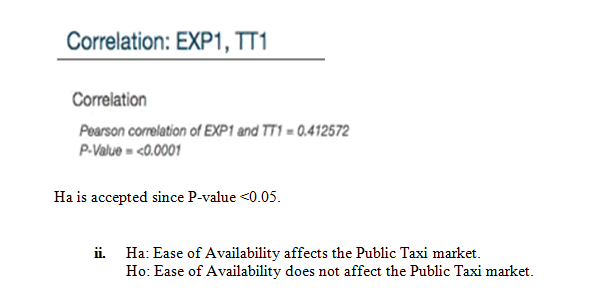
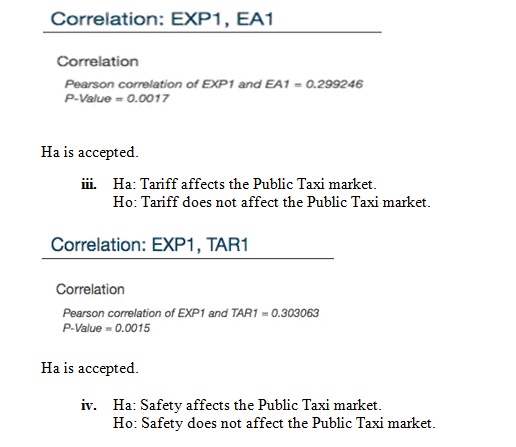
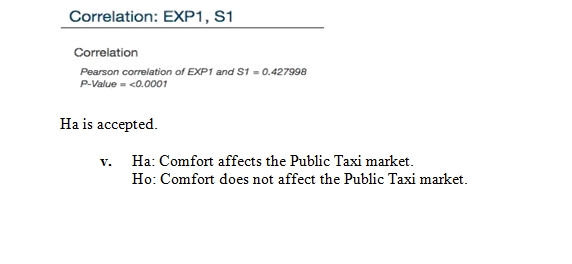
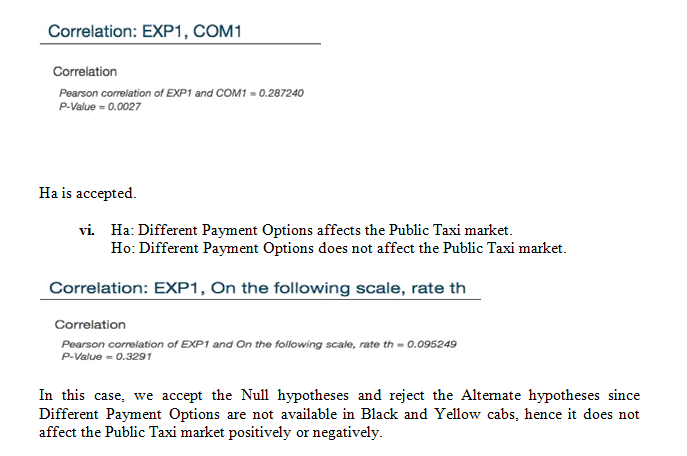
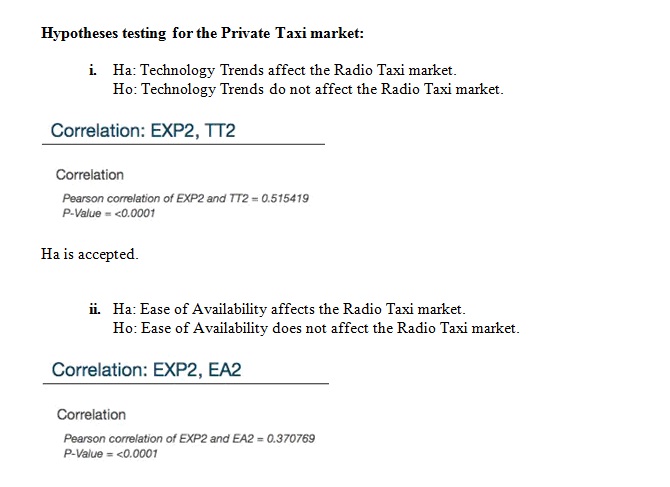
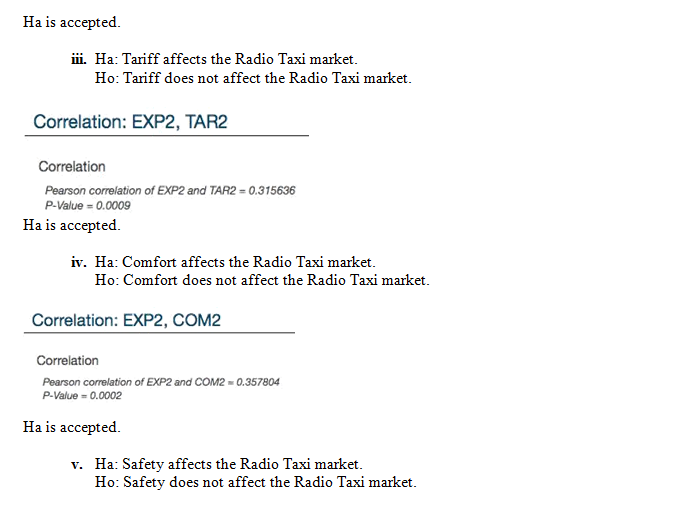
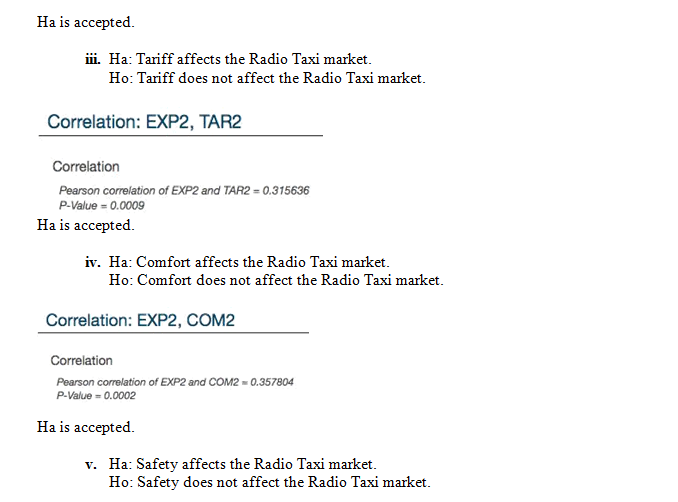
d. Paired Sample T-Test:
This statistical technique is used for comparing two population means in case there is a correlation between the two samples. Also the test is used for before-after study and when the samples are matching pairs.
To study the impact of the radio cabs on the cab industry usage, we have performed a paired t-test which compared the individual parameters of Public Taxis and Radio Taxis which were similar & affected its usage. Based on the data collected from the responses of the users, the following results were obtained.
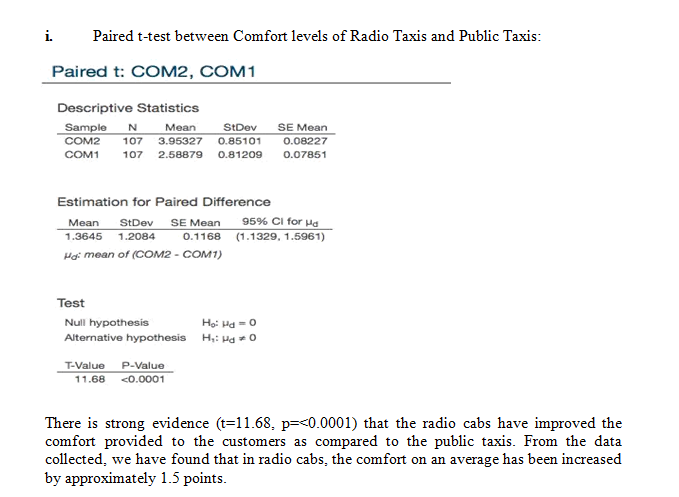
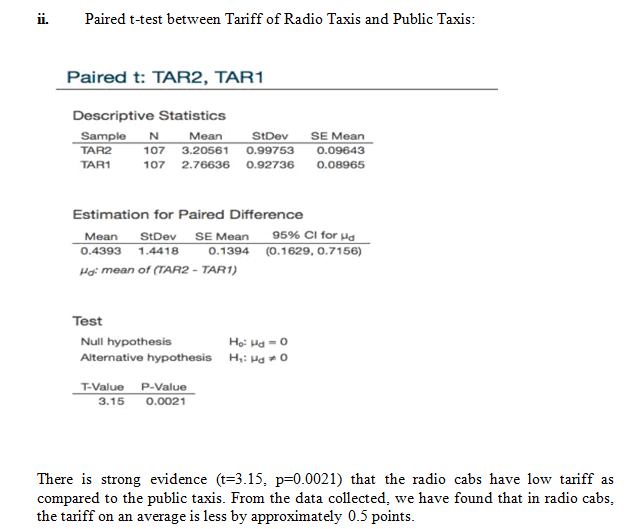

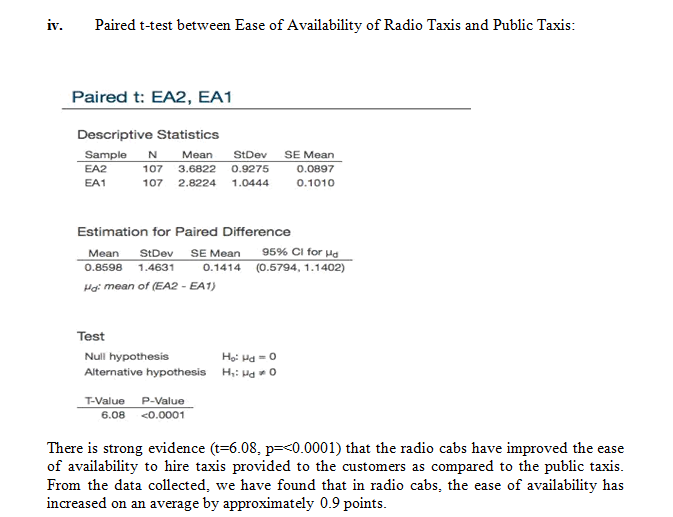
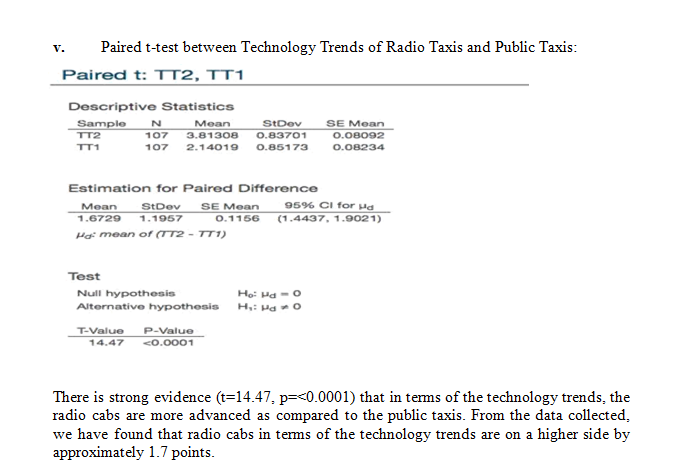
Summary and Conclusions
Due to increase in per capita income of the population in India, the usage of smartphones and Internet has increased since the past few years. As a result of this, the radio cab operators have found an opportunity to take the advantage of the growing technology trends by developing mobile taxi apps to overcome the drawbacks of the public taxi market and increase their market share. According to the responses received through the questionnaire circulated, the major benefits that appealed to the respondents while using the mobile taxi apps were the availability of various payment options and the 24x7 ease of availability of the taxis. Also, one of the major factors contributing to the use of the mobile taxi apps was the availability of GPS tracking on the smartphones through which the customers can track the taxi location which was a major drawback in the public taxis as result of which customers found radio cabs more secure to travel at night.
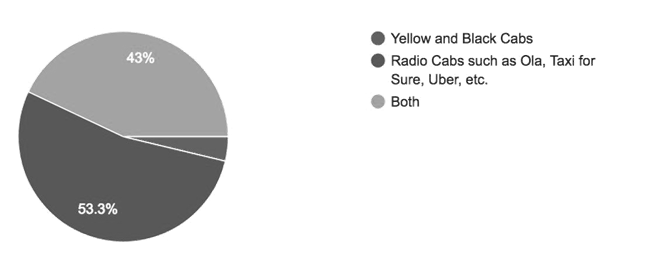
As seen above from the data collected from the respondents, we see that people prefer radio cabs as a safer option to travel at night because in public taxis, there were no GPS tracking facilities available and also in the radio cab service, the driver information of the cab was made available to the customers on the mobile app. Also, another factor, which is affecting the usage of the public taxis, is the comfort level that is provided in the vehicles. Since the vehicles which were being used by the black and yellow cab operators were quite old and since they didn’t introduce newer vehicles available in the market, the radio cab operators took over the public taxi market by introduction of newer and safer vehicles which had improved facilities like air conditioning, proper seating, availability of different types of vehicles depending on the usage, Wi-Fi, etc. This gave radio cab operators a competitive edge over the public taxi market hence impacting the usage of the public taxis.Keeping in mind all the facilities provided by the radio taxi operators another major factor that gave the radio cab operators a competitive edge over the public taxi operators was the pricing strategy being used. The lower per kilometre rates, tariffs being charged according to the utility of the vehicles and the discounts provided heavily affected the use of the public taxis.Nowadays because of the increasing technological trends the use of mobile wallets and online payment options such as credit card and debit card is increasing, keeping this in mind the radio cab operators have introduced different payment options, which are not available in the public taxi market. Hence this has also impacted the use of public taxis and thus due to all these factors the radio cab operators are heavily impacting the use of the public taxis and constantly increasing their market share.
Hence by collecting, analyzing and studying the data, we conclude that the independent variables considered by us like the technology trends, comfort, safety, price, ease of availability and the payment options are indeed affecting the public taxi market as the radio taxi operators had a competitive edge over them, they managed to analyze the changing market trends and introduced the mobile booking app with the growing use of the internet and smartphones. The mobile apps which were developed helped them to take the advantage of the technology trends like GPS tracking which enhanced the safety of the users & also along with the availability of various payment options like mobile wallets, debit/credit cards, they highly impacted the public taxi market & were able to capture a major amount of the overall taxi market share. Pricing strategies used by the radio cab operators also led to the decline in the usage of the public taxis since the discounts offered by radio cab operators were huge, & also the per KM rate of the cabs of the radio operators were less as compared to the public cab operators. The values obtained after performing the various data analysis methods also came out to be consistent, which reflects that the analysis methods chosen by us were favourable and the data collected through the by questionnaire circulated was reliable.
While collecting the responses through the questionnaire, there were some responses where in the samples did not answer the questionnaire in the intended manner. Thus to overcome these misleading responses we discarded some of the responses. Initially we had 137 responses out of which only 107 were desirable and rest were redundant.
Impact of the upcoming technology trends on the taxi market usage can be studied. The government has started implementing various policies keeping in mind the safety of the commuters and also to avoid the radio cab operators monopoly in the taxi market after there were various strikes from the public taxi union workers. Hence, the impact of these government policies on the taxi market usage in future can also be studied.
SCHEMES AND THEIR INTEGRATION IN SUSTAINABLE URBAN TRANSPORT SYSTEMS. Overview paper for Expert Group Meeting on Sustainable Urban Transport: Modernizing and greening taxi fleets in Latin American Cities.
Opportunities, 2019. Reuters. Retrieved from http://www.reuters.com